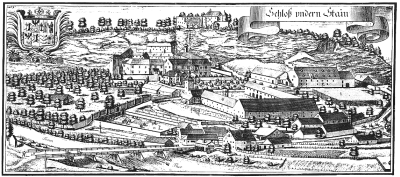Stein Castle (Bavaria) on:
[Wikipedia]
[Google]
[Amazon]

 Stein Castle (german: Schloss Stein) in Stein an der Traun is the most important
Stein Castle (german: Schloss Stein) in Stein an der Traun is the most important
Schlossbrauerei SteinSchule Schloss SteinStein Castle and its famous occupant, Heinz
{{Coord, 47.986625, N, 12.546381, E, type:landmark_region:DE-BY, display=title Castles in Bavaria Cave castles Traunstein (district)

 Stein Castle (german: Schloss Stein) in Stein an der Traun is the most important
Stein Castle (german: Schloss Stein) in Stein an der Traun is the most important cave castle
A cave castle (german: Höhlenburg) or grotto castle (German: ''Grottenburg'') is a residential or refuge castle that has been built into a natural cave. It falls within the category of hill castles. Unlike other types (such as water castles), s ...
in Germany
Germany,, officially the Federal Republic of Germany, is a country in Central Europe. It is the second most populous country in Europe after Russia, and the most populous member state of the European Union. Germany is situated betwe ...
.
The castle comprises three elements:
* the upper house on the almost 50 metre high steeply sloping ''nagelfluh
Conglomerate () is a clastic sedimentary rock that is composed of a substantial fraction of rounded to subangular gravel-size clasts. A conglomerate typically contains a matrix of finer-grained sediments, such as sand, silt, or clay, which fill ...
'' rock face;
* the cave castle beneath it, which hides a passage to the Traun valley in the rock;
* the lower house in Stein itself.
History
The origins of the upper house are not totally clear. It may have stemmed from a fortification dating to the Roman or Celtic period. Stein was first recorded in 1135. The romantic figure of the legendary robber knight, Hainz von Stein dem Wilden, is closely associated with the castle. He is supposed to have lived in the castle in the early 13th century and was written about for the first time by Lorenz Huebner in 1783 in a "tragic drama about the fatherland". The castle itself was in the possession of the Toerring family from the 13th century to 1633 . Albert von Toerring-Stein was theBishop of Regensburg
The Bishops of Regensburg (Ratisbon) are bishops of the Roman Catholic Diocese of Regensburg, Bavaria, Germany.
from 1613 to 1649. Adam Lorenz von Toerring-Stein
Adam; el, Ἀδάμ, Adám; la, Adam is the name given in Genesis 1-5 to the first human. Beyond its use as the name of the first man, ''adam'' is also used in the Bible as a pronoun, individually as "a human" and in a collective sense as " ...
held the same office from 1663 to 1666.
Count Carl Fugger von Kirchberg bought the property from the Toerrings in 1633. Later it passed by marriage to the lords (''Freiherren'') of Lösch.
In 1818 a 2nd class patrimonial court was established in the old Hofmark in the wake of reforms in Bavaria
Bavaria ( ; ), officially the Free State of Bavaria (german: Freistaat Bayern, link=no ), is a state in the south-east of Germany. With an area of , Bavaria is the largest German state by land area, comprising roughly a fifth of the total lan ...
. In 1845 Amélie de Beauharnais
''Amélie'' (also known as ''Le Fabuleux Destin d'Amélie Poulain''; ; en, The Fabulous Destiny of Amélie Poulain, italic=yes) is a 2001 French-language romantic comedy film directed by Jean-Pierre Jeunet. Written by Jeunet with Guillaume La ...
, widow of the emperor of Brazil, bought Stein Castle for herself and her daughter. In 1848 she ceded the Stein Court to the state as compensation.
In 1890 Stein Castle went to Count Joseph zu Arco-Zinneberg. In 1928 the Arco-Zinneberg had to cut down the great St. George's Forest in order to sell the wood to get out of debt. Despite that they had to sell up, the forest was possessed by the state and was immediately reforested.
Upper house, rock castle and lower house are today the property of the newly built Stein Castle Brewery (''Schlossbrauerei Stein''), founded in 1907, which has been in the ownership of the Wiskott family since 1934. The lower house in Stein has housed a private boarding school since 1948, the ''Schule Schloss Stein''.
External links
Schlossbrauerei Stein
{{Coord, 47.986625, N, 12.546381, E, type:landmark_region:DE-BY, display=title Castles in Bavaria Cave castles Traunstein (district)